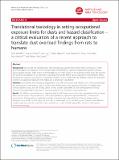Translational toxicology in setting occupational exposure limits for dusts and hazard classification – a critical evaluation of a recent approach to translate dust overload findings from rats to humans
Author(s)
Morfeld, Peter; Bruch, Joachim; Levy, Len; Ngiewih, Yufanyi; Chaudhuri, Ishrat; Muranko, Henry J; Myerson, Ross; McCunney, Robert J.; ... Show more Show less
Download12989_2015_Article_79.pdf (1.147Mb)
OPEN_ACCESS_POLICY
Open Access Policy
Creative Commons Attribution-Noncommercial-Share Alike
Metadata
Show full item recordAbstract
Background
We analyze the scientific basis and methodology used by the German MAK Commission in their recommendations for exposure limits and carcinogen classification of “granular biopersistent particles without known specific toxicity” (GBS). These recommendations are under review at the European Union level. We examine the scientific assumptions in an attempt to reproduce the results. MAK’s human equivalent concentrations (HECs) are based on a particle mass and on a volumetric model in which results from rat inhalation studies are translated to derive occupational exposure limits (OELs) and a carcinogen classification.
Methods
We followed the methods as proposed by the MAK Commission and Pauluhn 2011. We also examined key assumptions in the metrics, such as surface area of the human lung, deposition fractions of inhaled dusts, human clearance rates; and risk of lung cancer among workers, presumed to have some potential for lung overload, the physiological condition in rats associated with an increase in lung cancer risk.
Results
The MAK recommendations on exposure limits for GBS have numerous incorrect assumptions that adversely affect the final results. The procedures to derive the respirable occupational exposure limit (OEL) could not be reproduced, a finding raising considerable scientific uncertainty about the reliability of the recommendations. Moreover, the scientific basis of using the rat model is confounded by the fact that rats and humans show different cellular responses to inhaled particles as demonstrated by bronchoalveolar lavage (BAL) studies in both species.
Conclusion
Classifying all GBS as carcinogenic to humans based on rat inhalation studies in which lung overload leads to chronic inflammation and cancer is inappropriate. Studies of workers, who have been exposed to relevant levels of dust, have not indicated an increase in lung cancer risk. Using the methods proposed by the MAK, we were unable to reproduce the OEL for GBS recommended by the Commission, but identified substantial errors in the models. Considerable shortcomings in the use of lung surface area, clearance rates, deposition fractions; as well as using the mass and volumetric metrics as opposed to the particle surface area metric limit the scientific reliability of the proposed GBS OEL and carcinogen classification.
Date issued
2015-04Department
Massachusetts Institute of Technology. Department of Biological EngineeringJournal
Particle and Fibre Toxicology
Publisher
BioMed Central
Citation
Morfeld, Peter, Joachim Bruch, Len Levy, Yufanyi Ngiewih, Ishrat Chaudhuri, Henry J Muranko, Ross Myerson, and Robert J McCunney, et al. “Translational Toxicology in Setting Occupational Exposure Limits for Dusts and Hazard Classification – a Critical Evaluation of a Recent Approach to Translate Dust Overload Findings from Rats to Humans.” Particle and Fibre Toxicology 12, no. 1 (December 2015).
Version: Final published version
ISSN
1743-8977